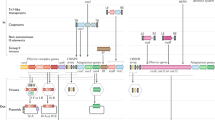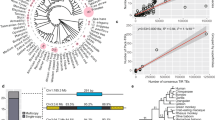Abstract
The Drosophila genetic element copia is one of the best studied eukaryotic transposable sequences. Copia shares structural features with a wide variety of mobile elements in Drosophila1,2, Lepidoptera3, yeast4,5 and vertebrates1,2, the last class being the retrovirus proviruses. Furthermore, retrovirus-like particles containing copia RNA have been isolated from Drosophila cells6 and extrachromosomal circular copias with structures closely resembling circular retrovirus proviruses have been isolated and cloned7,8. Therefore, copia-like elements and retroviruses may be members of a class of mobile genetic elements existing throughout the eukaryotic kingdom. Consequently, there has been speculation that retroviruses evolved from transposable elements7–9 and, conversely, that copia-like elements transpose as retroviruses or retrovirus-like particles6–8. To date, however, there has been no demonstration that copia RNA is reverse transcribed into copia DNA. The present report describes the isolation of linear extrachromosomal copias whose structure closely resembles the analogous retrovirus provirus linears and whose synthesis is unaffected by inhibitors of the cellular DNA polymerase responsible for chromosomal DNA replication.
This is a preview of subscription content, access via your institution
Access options
Subscribe to this journal
Receive 51 print issues and online access
$199.00 per year
only $3.90 per issue
Buy this article
- Purchase on Springer Link
- Instant access to full article PDF
Prices may be subject to local taxes which are calculated during checkout
Similar content being viewed by others
References
Rubin, G. M. et al. Cold Spring Harb. Symp. quant. Biol. 45, 619–628 (1981).
Varmus, H. E. in Mobile Genetic Elements (ed. Shapiro, J. A.) (Academic, New York, 1982).
Miller, D. W. & Miller, L. K. Nature 299, 562–564 (1982).
Farabaugh, P. J. & Fink, G. R. Nature 286, 352–356 (1980).
Gafner, J. & Philippsen, P. Nature 286, 414–418 (1980).
Shiba, T. & Saigo, K. Nature 302, 119–124 (1983).
Flavell, A. J. & Ish-Horowicz, D. Nature 292, 591–595 (1981).
Flavell, A. J. & Ish-Horowicz, D. Cell 34, 415–4l9 (1983).
Temin, H. M. Cell 21, 599–600 (1980).
Varmus, H. E. & Shank, P. R. J. Virol. 18, 567–573 (1976).
Hirt, B. J. molec. Biol. 26, 365–369 (1967).
Southern, E. M. J. molec. Biol. 98, 503–517 (1975).
Jacob, S. T. (ed.) Enzymes of Nucleic Acid Synthesis and Modification Vol. 1, 54–55 (CRC Press, Boca Raton, Florida, 1983).
Hagino-Yamagishi, K., Kano, K. & Mano, Y. Biochem. biophys. Res. Commun. 102, 1372–1378 (1981).
Hsu, T. W. & Taylor, J. M. J. Virol. 44, 493–498 (1982).
Hubscher, U., Kuenzle, C. C. & Spadari, S. Proc. natn. Acad. Sci. U.S.A. 76, 2316–2320 (1979).
Tooze, J. (ed.) DNA Tumour Viruses. Molecular Biology of Tumour Viruses 2nd edn (Cold Spring Harbor Laboratory, New York, 1981).
Yang, S. S. & Wivel, N. A. J. Virol. 13, 712–720 (1974).
Kuff, E. L. et al. Proc. natn. Acad. Sci. U.S.A. 80, 1992–1996 (1983).
Heine, C. W., Kelly, D. C. & Avery, R. J. J. gen. Virol. 49, 385–395 (1980).
Fink, G., Farabaugh, P., Roeder, G. & Chaleff, D. Cold Spring Harb. Symp. quant. Biol. 45, 575–580 (1980).
Copeland, N. G., Hutchison, K. W. & Jenkins, N. A. Cell 33, 379–387 (1983).
Sinclair, J. H., Sang, J. H., Burke, J. F. & Ish-Horowicz, D. Nature 306, 198–200 (1983).
Eschalier, G. & Ohanessian, A. In Vitro 6, 162–172 (1970).
Author information
Authors and Affiliations
Rights and permissions
About this article
Cite this article
Flavell, A. Role of reverse transcription in the generation of extrachromosomal copia mobile genetic elements. Nature 310, 514–516 (1984). https://doi.org/10.1038/310514a0
Received:
Accepted:
Issue Date:
DOI: https://doi.org/10.1038/310514a0
This article is cited by
-
Genetic variation of copia suppression in Drosophila melanogaster
Heredity (2011)
-
Localized expression of a novel micropia-like element in the blastoderm of Drosophila melanogaster is dependent on the anterior morphogen bicoid
Chromosoma (1994)
-
Ty1-copia group retrotransposons and the evolution of retroelements in the eukaryotes
Genetica (1992)
-
Retroviral-mediated gene transfer
Molecular Neurobiology (1988)
-
Movement of Drosophila melanogaster transposable elements other than P elements in a P-M hybrid dysgenic cross
Molecular and General Genetics MGG (1987)
Comments
By submitting a comment you agree to abide by our Terms and Community Guidelines. If you find something abusive or that does not comply with our terms or guidelines please flag it as inappropriate.



